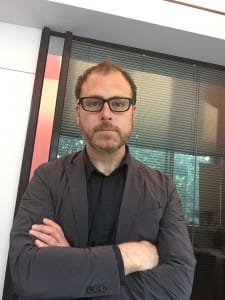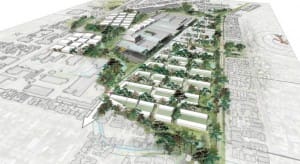The outward-looking creative
Before my meeting with Professor Diego Ramirez-Lovering, I had an image of the architect as the archetypal solitary creative: hunched over a slanted desk, pencil in hand, with nothing but his sketches and his creative vision for company. Diego defies this archetype, throwing the creative process open to contribution from various individuals, disciplines, and inspirations. Establishing Monash’s School of Architecture in 2008 with colleague Professor Shane Murray (now Dean of Monash Art Design and Architecture, or MADA), Diego says he was keen on establishing a school for the 21st century with an education program that interacted with other disciplines and professions. Only with these broad influences can architecture make its most meaningful contributions to the urban environment: those that bolster local communities against social and environmental challenges.
Diego has a strong interest in the larger systems that drive cities, “the economic, social, and environmental contexts within which architecture is found”. Economic challenges such as housing affordability or environmental challenges like water scarcity are not merely obstacles to be overcome in the design process. Rather, a practical challenge is a source of creative inspiration, a lens through which he may view architecture in a new light.
 With the advent of climate change such practical challenges abound, particularly in the area of water sensitive design. Climate change will bring an increasing number of extreme water events, from drought to flooding – demanding a complete rethink of urban design. “The notion, for example, that we flush toilets with potable water – water that you can drink – is complete and utter madness,” says Diego. The CRC for Water Sensitive Cities (CRCWSC) is a natural home for such rethinking. Diego views individual disciplines alone as ineffective in solving challenges such as those presented by climate change. This is why the CRCWSC’s environment of interdisciplinary engagement is so important. It provides a meeting of minds from various backgrounds, and allows for creative problem-solving in new ways.
With the advent of climate change such practical challenges abound, particularly in the area of water sensitive design. Climate change will bring an increasing number of extreme water events, from drought to flooding – demanding a complete rethink of urban design. “The notion, for example, that we flush toilets with potable water – water that you can drink – is complete and utter madness,” says Diego. The CRC for Water Sensitive Cities (CRCWSC) is a natural home for such rethinking. Diego views individual disciplines alone as ineffective in solving challenges such as those presented by climate change. This is why the CRCWSC’s environment of interdisciplinary engagement is so important. It provides a meeting of minds from various backgrounds, and allows for creative problem-solving in new ways.
Part of Diego’s work with the CRCWSC involves facilitating this meeting of minds in the project Urban Intensification and Green Infrastructure: towards a water sensitive city (Project D5.1). He coordinates various institutions and project partners, as they collaborate to develop best-practice design guidelines for water sensitive building projects at different scales (ranging from a single house to an entire city precinct). Diego views architecture and other design disciplines as ideally situated for such interdisciplinary facilitation, as “integrators of different disciplinary inputs”. It certainly helps that he relishes this part of his own work. “I love working with people,” he says. “I really like the conversations and collaborations.”
It is not just his own enjoyment that drives Diego’s passion for his work. His background as the son of an architect in Mexico has given him a keen social conscience. Being exposed to an extreme polarisation of wealth and seeing how enlightened design could work in favour of the social good, Diego felt a responsibility to use his education for the benefit of those less fortunate. “I felt a calling at that point. It all fell into place.”
 Diego’s ambitions for the future reflect this social conscience. What does he hope to be doing ten years from now? Diego says he wants to be engaged in similar work but with greater reach: leading others in the use of design to tackle social, economic, and environmental issues on a global scale. Leaving my meeting with Diego, my mental image of the architect of the 21st century has changed. Not solitary, but surrounded by a dynamic intellectual community, open to creative inspiration from unexpected corners. Not insular, but continually outward-looking.
Diego’s ambitions for the future reflect this social conscience. What does he hope to be doing ten years from now? Diego says he wants to be engaged in similar work but with greater reach: leading others in the use of design to tackle social, economic, and environmental issues on a global scale. Leaving my meeting with Diego, my mental image of the architect of the 21st century has changed. Not solitary, but surrounded by a dynamic intellectual community, open to creative inspiration from unexpected corners. Not insular, but continually outward-looking.
Christina Majoinen for the Mind Your Way team